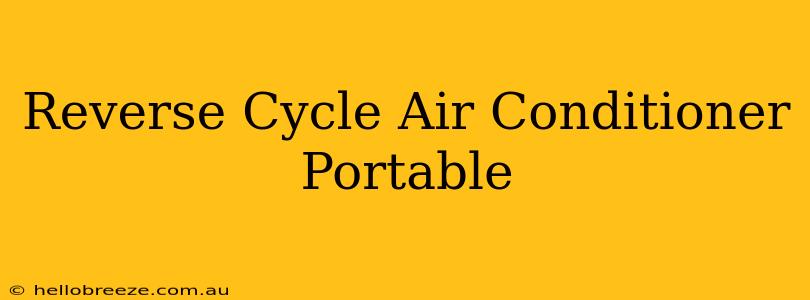Are you looking for a versatile and efficient way to control the temperature in your home? A portable reverse cycle air conditioner might be the perfect solution. These innovative units offer both heating and cooling capabilities, providing year-round comfort without the need for extensive installation. This comprehensive guide will explore the benefits, features, and considerations when choosing a portable reverse cycle air conditioner.
What is a Portable Reverse Cycle Air Conditioner?
A portable reverse cycle air conditioner is a self-contained unit that can easily be moved from room to room. Unlike traditional split-system air conditioners, these don't require professional installation. The "reverse cycle" feature allows the unit to switch between heating and cooling modes, making it a cost-effective solution for managing indoor temperatures throughout the year.
Key Advantages of Portable Reverse Cycle Air Conditioners:
- Portability: The biggest advantage is their mobility. You can easily move the unit to whichever room needs climate control most.
- Heating and Cooling: Enjoy both heating and cooling functions in one compact device, saving you money and space.
- Cost-Effective: Generally less expensive to purchase and install than traditional split systems.
- Easy Installation: No need for professional installers; simply plug it in and go.
- Energy Efficiency: Modern models offer improved energy efficiency ratings, helping to keep your energy bills down.
Choosing the Right Portable Reverse Cycle Air Conditioner
Selecting the right unit depends on your individual needs and the size of the room you intend to cool or heat. Consider the following factors:
1. BTU Rating (British Thermal Units):**
The BTU rating indicates the unit's cooling and heating capacity. Higher BTU ratings are suitable for larger rooms, while lower ratings are sufficient for smaller spaces. Carefully calculate the BTU requirements for your room to ensure optimal performance.
2. Energy Efficiency Rating (EER):**
The EER measures the unit's energy efficiency. A higher EER indicates that the unit consumes less energy to produce the same amount of cooling or heating. Look for units with a high EER rating to minimize your energy bills.
3. Features and Functionality:**
Many portable reverse cycle air conditioners offer additional features such as:
- Dehumidification: Removes excess moisture from the air, improving comfort levels, especially during humid weather.
- Programmable Timer: Allows you to schedule the unit to turn on and off automatically.
- Remote Control: Conveniently control the unit's functions from a distance.
- Sleep Mode: Provides a quieter and more energy-efficient operation during nighttime hours.
Installation and Maintenance
While portable reverse cycle air conditioners are easy to install, it’s crucial to follow the manufacturer's instructions carefully. Proper ventilation is vital for efficient operation. Many units require a vent hose to exhaust hot air, so ensure you have suitable access to a window or door.
Regular maintenance is essential to prolong the lifespan of your unit and ensure optimal performance. This includes:
- Cleaning the air filter: Regularly clean or replace the air filter to maintain air quality and efficiency.
- Checking the condensate drain: Ensure the condensate drain is clear to prevent water buildup.
- Inspecting the vent hose: Make sure the vent hose is properly connected and free from obstructions.
Portable Reverse Cycle Air Conditioners vs. Traditional Split Systems
While portable units offer convenience and affordability, traditional split systems often boast superior cooling and heating capabilities, particularly in larger spaces. Consider your budget, the size of your home, and your individual needs when making your decision.
Conclusion
A portable reverse cycle air conditioner offers a flexible and convenient solution for managing indoor temperatures year-round. By understanding your needs and carefully considering the features discussed above, you can choose the perfect unit to enhance your comfort and save on energy costs. Remember to always prioritize safety and follow manufacturer instructions for installation and maintenance.

